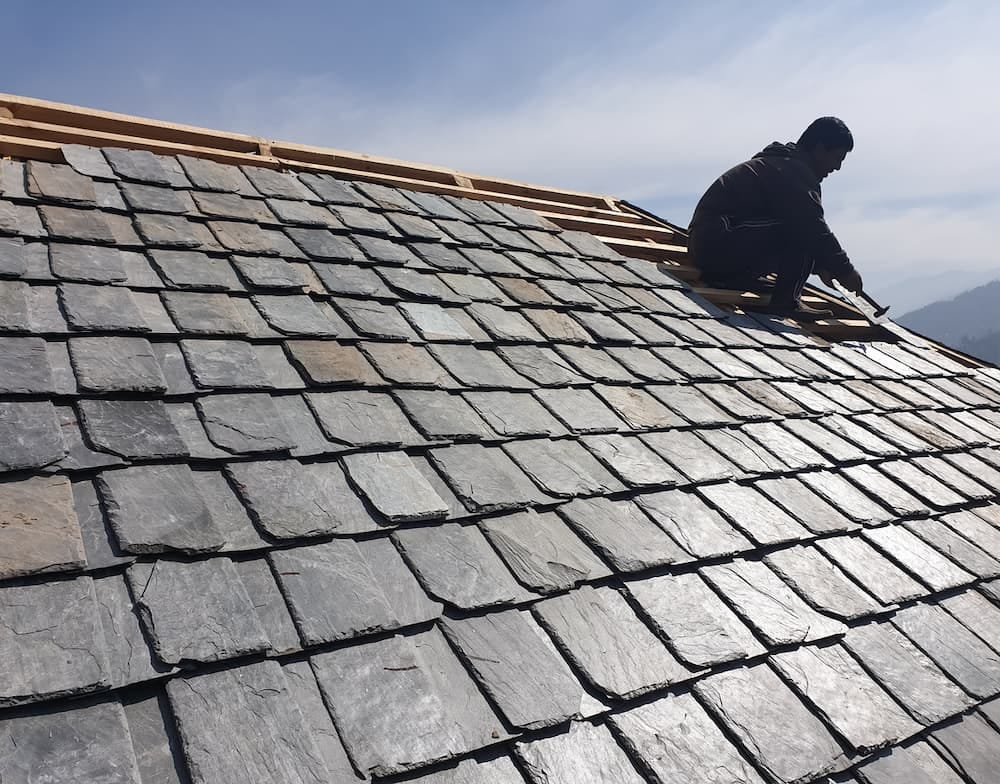Reliable & On-Time Roofers
Same-Day & Emergency Help
Free, No-Obligation Quotes
Fast, Reliable and Affordable

Return to Page
Enter Your Zip Code:
Thank you! Your submission has been received!
Oops! Something went wrong while submitting the form.
Top-Notch Slate Roofers
Fast & Free Quotes
Call us to receive a fast and free no-obligation roofing quote on any installation, replacement or repair.
Licensed & Insured
Rest assured knowing our roofers have years of training and our work is 100% guaranteed.
All Types of Roofs
Roofers are available to fix any issues today! We are open 24/7.

We'll Repair Any Slate Roof
At Local Roofers, we specialize in repairing and fixing any type of slate roofing issue you may encounter. Whether it's a minor leak, damaged slates, or more extensive storm damage, our experienced team is equipped to handle it all. We use top-quality materials and proven techniques to ensure your roof is restored to its best condition, providing you with peace of mind and long-lasting protection for your home.

Leak Detection & Repair

Slate Replacement

Flashing Repair

Gutter Repair

Roof Replacement

Roof Vent Repair

Chimney Repair

Skylight Repair

Roof Patching

Fascia Repair

Soffit Repair

Repairing Roof Sagging

Ridge Cap Repair

Ice Dam Removal

Underlayment Repair

Storm Damage Repair

Slate Sealing

Fix Missing Nails

Reattach Loose Slates

Slate Roof Repair

And More!
Reliable & Honest Roofers
Choosing our roofers ensures that you receive service from experienced professionals dedicated to excellence. We use the latest tools and techniques to diagnose and solve roofing issues efficiently, saving you time and money. Whether it's a minor repair or a whole roof replacement, we use the highest quality products to get the job done right the first time. Hire us for a hassle-free, quality roofing experience you can trust.

Roof Replacement

Roof Repair

Roof Installation

Roof Inspections

Roof Cleaning

Gutters

Asphalt Shingles

Metal Roofing

Slate Roofing

Wood Shingles & Shakes

Concrete Tiles

Solar Shingles

Rubber Roofing

Flat Roofing

Leak Detection & Repair

Flashing Repair

Roof Vents

Skylights

Roof Patching & Sealing

Ice Dams

And More!
How to Fix a Slate Roof
Fixing a slate roof involves several steps, depending on the extent of the damage. Here’s our process for fixing a slate roof issue.
1. Inspect the Roof
- Safety First: Use a sturdy ladder and safety gear. Slate roofs can be slippery, so consider using roof jacks or a safety harness.
- Identify the Problem: Look for missing, cracked, or slipped slates, as well as any signs of leaks or water damage.
2. Gather Materials and Tools
- Materials: Replacement slate tiles, copper or stainless steel nails, slate hooks (if applicable), roofing felt, and copper flashing.
- Tools: Slate ripper, slate hammer, ladder, pry bar, and safety harness.
3. Remove the Damaged Slate
- Use a Slate Ripper: Slide the slate ripper under the damaged slate to cut the nails holding it in place. The ripper hooks onto the nails, allowing you to cut or remove them.
- Remove the Slate: Carefully slide the damaged slate out, being cautious not to damage the surrounding slates.
4. Install the Replacement Slate
- Prepare the New Slate: If needed, drill a hole in the replacement slate using a slate hammer or a drill with a masonry bit. The hole should be near the top of the slate.
- Slide the Slate into Place: Position the replacement slate so that it aligns with the surrounding slates. Ensure that it overlaps properly to maintain the roof's waterproofing.
- Secure the Slate:
- Nailing: Use copper or stainless steel nails to secure the new slate. Drive the nails in carefully to avoid cracking the slate. Cover the nails with a piece of roofing felt to prevent water penetration.
- Slate Hook: If using a slate hook, slide the hook over the slate below and hang the new slate on the hook. This method avoids the need for nailing.
5. Replace Flashing (if needed)
- Remove Old Flashing: Use a pry bar to carefully remove the old flashing if it's damaged or corroded.
- Install New Flashing: Cut a piece of copper flashing to fit the area, such as around a chimney or in a roof valley. Secure it in place with copper nails and ensure it is properly sealed to prevent leaks.
6. Check and Repair Roof Valleys
- Inspect Valleys: Look for any signs of wear or damage in the roof valleys, where two roof slopes meet.
- Repair or Replace: If the metal valley flashing is damaged, remove the old flashing and install new copper flashing, ensuring it is securely fastened and sealed.
7. Seal Small Cracks
- Use Roof Sealant: For minor cracks in the slates, you can apply a roof sealant that matches the color of the slate. This is a temporary fix and should be monitored regularly.
8. Check for Proper Ventilation
- Inspect Vents: Ensure that roof vents and attic ventilation are functioning correctly to prevent moisture buildup that can damage the slates.
- Repair or Replace: Fix any damaged vents or ventilation components as needed.
9. Monitor After Repairs
- Check for Leaks: After completing the repairs, monitor the roof during the next rainstorm to ensure that the repairs were successful and that there are no leaks.
10. Perform Regular Maintenance
- Inspect Annually: Regularly inspect the roof to catch any potential issues early. Maintaining the roof will extend its life and prevent costly repairs in the future.
By following these steps, you can effectively fix a slate roof and extend its lifespan. For more extensive damage or if you're unsure of the repair process, consider hiring our professional roofing company to ensure the job is done correctly.



